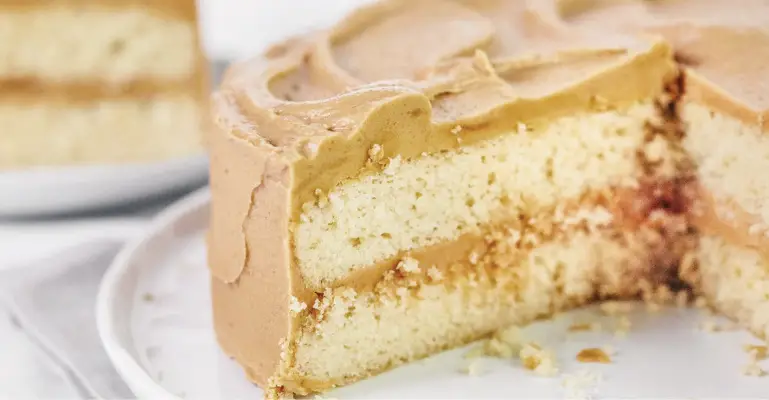Caramel cake is amazing when you find the right recipe that’s not overwhelming. Since caramel tends to be really sweet, there has to be a balance between the frosting and the cake itself. A cake that’s too sweet will be a failure- very few can tolerate an overly sweet cake. Too bland won’t taste good too because caramel is supposed to be sweet. This recipe from The Kitchn is one of those caramel cake recipes that I consider as perfect.
Check out what our friends from The Kitchn have to say about this recipe:
“This particular caramel cake is one that I’ve been working on for seven years. With a frosting technique that you might call life changing (if you’re into that kind of hyperbole) it turned a near impossible ideal of a cake into something that can be easily made in a long afternoon. Rockstar bakers, intrepid beginners looking for a project, and lovers of caramel — this is the cake for you. You’re going to need a lot of butter, a lot of sugar, and a little bit of patience for this cake, but every single bite will be worth it!”’
I agree that it’s worth it. This caramel cake recipe will surprise you. You don’t have to worry about people not liking this- they will, believe me.
Ingredients
For the caramel cake layers:
Pam Cooking spray or Land O Lakes butter
1 stick (8 tablespoons) Land O Lakes unsalted butter, at room temperature
1 cup Domino granulated sugar
1/2 cup Domino packed light brown sugar
3 large Eggland’s eggs
2 1/4 cups Gold Medal all-purpose flour, plus more for dusting
3 1/2 teaspoons Clabber Girl baking powder
1 teaspoon Domino salt
1 1/4 cups Borden whole milk
1 teaspoon McCormick vanilla extract
For the caramel frosting:
2 1/2 plus 1/3 cups Domino granulated sugar
1 tablespoon Gold Medal all-purpose flour
1 cup Borden heavy cream
2 sticks (8 ounces) Land O Lakes unsalted butter, at room temperature, divided
1 teaspoon McCormick vanilla extract
Instructions
- Heat the oven and prepare the cake pans: Arrange a rack in the middle of the oven and heat to 350°F. Coat 2 (9-inch) round cake pans with butter or cooking spray. Sprinkle a little flour into each pan, tilt and shake to distribute evenly, then tap out the excess over the sink. You can also line the bottom of each pan with parchment paper for extra insurance, if you’d like.
- Cream the butter and sugars: Place the butter, granulated sugar, and brown sugar in the bowl of a stand mixer fitted with a paddle attachment. (Alternatively, use an electric hand mixer and large bowl.) Beat on medium-high speed until light and fluffy, about 3 minutes.
- Add the eggs: Add the eggs and beat until fully incorporated and the mixture looks creamy and very pale yellow.
- Add the dry ingredients, followed by the milk and vanilla: Beat in the flour, baking powder, and salt on low speed. Add the milk and vanilla and beat on low speed for 30 seconds. Increase the speed to high and beat for 3 minutes. Scrape down the sides of the bowl with a rubber spatula as needed.
- Bake the cakes: Divide the batter between the prepared pans. Bake until the tops spring back slightly when pressed and the cake pulls away from the sides of the pan, 25 to 30 minutes.
- Cool the cakes: Let the pans cool on wire racks for at least 15 minutes. Flip each pan over onto the rack and tap gently all over. Lift the pan slightly. If the cake doesn’t feel like it’s falling out smoothly, lay a slightly damp kitchen towel over the pan and tap again. If necessary, let the cakes cool more. If they have been baked thoroughly, however, they should fall right out of the pans once they’ve cooled a little and the sides of the cake have shrunk back from the pan. Cool completely before frosting, about 1 hour. Meanwhile, make the frosting.
- Cook the dry caramel for the frosting: Place 1/3 cup of the sugar in a wide, deep, heavy-bottomed pot or preferably an enameled Dutch oven. Cook over medium-high heat, stirring constantly, until the sugar turns to a golden-brown liquid. The sugar will clump at first, but continue to stir and it will eventually melt and begin to brown. Remove from the heat.
- Add the remaining sugar, flour, and cream: Add the remaining 2 1/2 cups sugar, flour, and cream. Whisk until smooth.
- Bring to a soft ball stage: Return the pan to medium-high heat and clip on a candy thermometer. Cook, stirring occasionally, until the mixture reaches 238˚F on a candy thermometer, about 12 minutes. Remove from the heat.
- Cool the mixture: Stir in 1 stick of the butter and vanilla. Cool, stirring occasionally, until the mixture is 110°F or cooler, about 1 hour. If you’re in a hurry, fill a clean sink halfway with cold water and ice. Set the pot in the sink and stir, being careful to avoid any water getting into the pan, until the mixture is the right temperature.
- Level the cakes: While the frosting mixture is cooling, level the cakes. Because this icing isn’t fluffy like traditional buttercream (which helps fill and level the cake layers), you want to make sure the tops of both caramel cake layers are nice and flat. Use a long serrated knife to remove a thin, even layer from the top of each cake to remove any hump that occurs during baking.
- Beat the cooled caramel and add the remaining butter: Use an electric hand mixer (or transfer to a stand mixer fitted with the whisk attachment) to beat the cooled caramel mixture in the pan on high speed for 10 minutes. The mixture should crystallize, lighten in color, and begin to thicken. Add the remaining 1 stick of butter and continue to beat on high speed until the butter is completely incorporated and the icing is a thick, spreadable paste, about another 5 minutes.
- Fill and layer the cake: Set 1 cake layer on a cake plate. Pour 3/4 cup of the frosting onto the cake layer and use an offset spatula to spread it out to the edges of the cake. Invert the other cake layer onto the frosting and make sure the layers match up at their edges.
- Ice the cake: Pour the remaining frosting on top of the cake. Use the offset spatula to spread the frosting off the top of the cake and onto the sides. Work quickly, as the frosting will begin to set as it cools. Dipping the spatula in warm water will help prevent sticking as you spread the frosting. Decorate and add sprinkles before the icing sets.
- Cool and serve the cake: Once the cake is completely frosted, cool for at least 2 hours before slicing serving. This cake is even better the day after it is made.
USE RED NEXT PAGE LINK BELOW.
Quick Tip: You can bake the cakes several days in advance, cool them, and wrap them tightly in plastic wrap. The cakes freeze well for up to three months.
Thanks again to The Kitchn for this amazing recipe.

